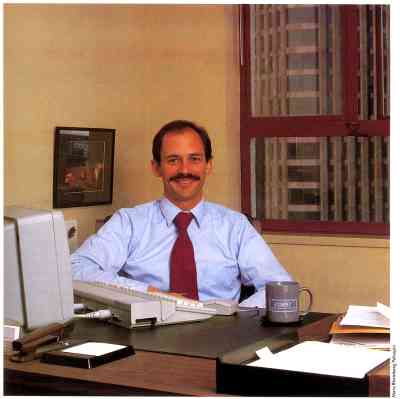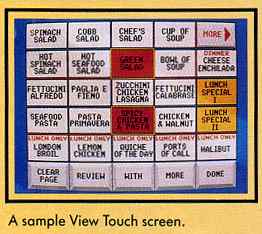BUSINESS
USING THE ST IN AN IBM WORLD
If you're a personal computer trying to make it in business and your initials aren't IBM, then you've got a tough haul. But even though corporate America has embraced Big Blue, the ST hasn't been entirely left out. STs are being use successfully in more and more businesses, and you can find them standing tall in the three-piece suit arena.
by GISELLE BISSON
The business world has finally begun embracing the Atari ST for highly specialized tasks- from designing orthopedic shoe inserts to running a dedicated restaurant menu system. But it seems only the most adventurous users are buying Atari computers for traditional office tasks such as database management, word processing and accounting- typically, tasks dominated by IBM or to a lesser extent, Apple.
However, with its Macintosh-like graphic operating system and color graphic abilities, the ST may actually be overqualified for the job. STs can do things that the MS-DOS establishment can only dream of, and that the Mac community can do - but at great cost. And with IBM and Macintosh emulators such as PC-Ditto and the Magic Sac, you can own an ST and have the best of both worlds.

Charles Dorsett, San Francisco lawyer, and his ST system.
Law Offices
Charles Dorsett is the maverick among the attorneys in the posh suite
of law offices he shares in downtown San Francisco-all because of the 1040
ST propped up with a law book on his desk. With the IB 5 1/4-inch IBM disk
drive and PC-Ditto, his Atari documents are compatible with the office's
NCR computer system and laser printer. Dorsett enjoys the luxury of using
1st Word or WordPerfect instead of the cumbersome IBM WordStar word processor.
He uses the Thunder! real-time spell checker as he prepares legal documents,
modifying the margins to fit legal pleading paper. After saving files in
ASCII format, his secretary inserts two simple WordStar commands at the
top of the file and prints them out.
PC-Ditto was the best solution to the problem of getting two computers
to share the same printer. "You can use a
multiplexer switch, but it's tricky, and you can crash the system,"
Dorsett explains. "Transferring files between IBM and ST computers with
two modems is the other possibility but both computers would be tied up
for five minutes every time I sent a file. And in this office, networking
wouldn't work," he adds. "We have a system that works now."
Dorsett watches other law offices struggle with their expensive, outdated computer systems. "I'd guess 98% of attorneys probably have computers already and are looking to upgrade their existing systems, but file compatibility problems discourage them," he says. "The most important thing in a law office is time-not money," Dorsett says. "It's too bad attorneys assume they will have fewer problems with a $1,000 computer than a $500 ST."
Retail Inventory
At PC Options, they use what they sell. The San Francisco Atari computer
dealer uses Sales Pro, a program from Hi-Tech Advisors to do inventory
and stock. "It does everything but wash the sink- customer, vendor inventory,"
says owner Chuck Thorpe "I know other retailers who use Multi-Manager but
I found the security on the system was excessive for a store my size. Everything
is at my fingertips. I interact with that machine all day long, and I'm
surprised how dependent I've gotten," he says. "When my hard disk crashed
once, I crashed."
The speed of a hard disk is essential. "You can't afford to have customers tapping their feet," he adds. After orders are tallied, a fast Epson EX 800 printer spits out a receipt. An inexpensive modem allows him to send information from Sales Pro to another ST dedicated to accounting with Financial Plus, a double-entry, full-featured accounting system that was originally developed for the IBM.
"The ST is as much of a business machine as the IBM," Thorpe says. "It's worth buying just for the time you save. When I use EZ-Calc, I can do things in seconds by grabbing cells with the mouse."
Engineering
"Atari is making a big mistake by not advertising in engineering magazines,"
says John Draper, an engineer with Contel, a Washington, D.C. telecommunications
contractor.
Draper and his associate Russ Falzone use the 520 and 1040 ST to design satellite communication systems. With CAD-3D 2.0, they simulate equipment rack elevations. "Russ brought his 520 in one day and I was impressed. with the graphics-he rotated a rack so you could see front and back. It was just gorgeous," Draper says. Draper still uses an Atari 8-bit "souped up to 256K" for schematics, drawings and writing equipment documentation, but plans to buy an ST soon, too. "The ST's a damn nice piece of equipment," he says. "For word processing you can't beat it. I think it's a bigger value than Apple or IBM, and with emulators you can run their programs anyway."
Accounting
"Maybe I'm the first," Bill Beckerman wonders sometimes. 'When I go
to user group meetings and they ask who does accounting, I'm the only one
who raises my hand. I'd certainly like to encourage people to use it,"
he says as he writes checks with his ST computer.
Beckerman runs his Oakland, California accounting business with a color 520 ST, double-sided drive and Supra 20-megabyte hard disk. Beckerman keeps 12 sets of books on Financial Plus, "a wonderful piece of software" from Equal Plus of Austin, Texas. "Though it takes a little expertise to set up, it's a simple program to operate," he says. "I'd recommend it for anyone who wants to do books for a small business." Once he's prepared a financial statement, Beckerman uses ST Writer to add details and prints it on his Citizen MMP 15, a printer with a wide carriage and "very acceptable" near-letter-quality mode.
His 64K Microstuffer printer buffer is an accounting essential. "It's large, but I fill it fast," he notes. "For one client, I have to print ten financial statements for ten properties at once I can print each statement three times, back them all up and finish doing all the adjustments on ST Writer while the printer runs." The only other piece of hardware in his office is a photocopier, "And the printer is so fast, I hardly use the copier anymore."
Desktop Publishing & Mail Order Systems
Phil Wright owns the only computer dealership in Fort St. John, British
Columbia, population 14,000. On the side, he creates Atari-generated advertisements
and flyers for the local suntan salon, dress shop and camera shop. And,
if things work out for him, most of Fort St. John's restaurants will soon
have STs, too.
Wright sells and customizes dedicated restaurant management systems using the touch screen from View Touch and the Mega 2 computer. (See the related story in the sidebar.) With NEOchrome, he designs colorful menus. Customers select food items by touching the screen, and the computer tallies up the bill.
But Wright mainly uses the ST to create advertisements and flyers with Easy Draw and the Star Micronics 24-pin printer. "By combining digitized graphics with Easy Draw we can do stuff that looks better than what you can do on a Mac," Wright states. Easy Draw utilizes GDOS to get the maximum resolution possible from the Star printer. "It looks almost as good as the Apple laser printer, and you can't produce that kind of graphic output on an IBM," he says.
The Bottom Line
When you add it up, the best reason to use the ST as a business computer
is price. In the early days of the ST, a lack of software and a keyboard
that couldn't easily be moved hampered its acceptance by the business community.
Now a substantial array of business software exists, and Atari's Megas,
with their separate keyboards and massive amounts of memory, have become
powerful additions to your desktop. For the small company purchasing its
first business computer system, the Atari ST makes a lot of sense.
If you'd like to see more articles like this, circle 159 on the Reader Service Card.
Giselle Bisson is a San Francisco-based free-lance writer who
specializes in business and technology. She is also a frequent contributor
to START and Antic.
| THE VIEW-TOUCH RESTAURANT
SYSTEM
The View Touch point-of-sale restaurant computer, designed to replace a cash register (and perhaps even employees) in restaurants, is one of the first truly vertical applications for the Atari Mega. The View Touch $4999 system includes a Mega 2 with color monitor glass touch screen network hardware, 40-column receipt printer, software and cash drawer. The computer offers dozens of menu pages drawn with NEOchrome. To order a hamburger customers simply touch a hamburger icon. The Mega adds up the items figures the tax and prints out a receipt. Computenzed cash registers have been used in high-volume restaurants and fast food chains for years but the View Touch is different because "We've eliminated the need for keys," says View Touch president Gene Mosher. It doesn't use Atari's GEM, either. View Touch created an entirely new user interface for the product. The menu can be changed frequently and, according to Mosher, the software can be customized without programming. The system, which will be distributed primarily through cash register companies instead of computer dealers, is also sold with a 25-inch Sony monitor and can be used for business or classroom presentation graphics.
|
Products Mentioned
-
WordPerfect 4.1 for the ST, $395. WordPerfect Corp., 280 W. Center
St.. Orem, UT 84057, (801) 227-4010.
CIRCLE 158 ON READER SERVICE CARD -
Thunder!, $39.95. Electronic Arts, 1820 Gateway Dr., San Mateo,
CA 94404, (415) 571-7991.
CIRCLE 160 ON READER SERVICE CARD -
lB Drive (40 track), $249.95. IB Computers, 1519 SW. Marlow Ave.,
Pordand, OR 97225, (503) 297-8425.
CIRCLE 161 ON READER SERVICE CARD -
Atari SH204 20-megabyte hard disk, $699.95. Atari Corp., 1196 Borregas
Aye, Sunnyvale, CA 94088, (408) 745-2000.
CIRCLE 162 ON READER SERVICE CARD -
Sales Pro Plus, $199. Hi-Tech Advisers, P.O. Box 7524, Winter Haven,
FL 33883, (813) 294-1885.
CIRCLE 163 ON READER SERVICE CARD -
Financial Plus, $199. Equal Plus Software, 1406 Camp Craft Rd.,
Ste 106, Austin, TX 78746, (512) 327-5484.
CIRCLE 164 ON READER SERVICE CARD -
Epson EX-800 Printer, $649. Epson America, 2780 Lomita Blvd., Torrance,
CA 90505, (213) 539-9140.
CIRCLE 165 ON READER SERVICE CARD -
64K Microstuffer Print Buffer, $69.95, 20-megabyte hard drive,
$699. Supra Corp., 1133 Commercial Way, Albany, OR 97321, (503) 967-9075.
CIRCLE 166 ON READER SERVICE CARD -
Easy Draw 2.0, $79.95. Migraph Inc., 333rd St., Suite 201, Federal
Way, WA 98003, (206) 838-4677.
CIRCLE 167 ON READER SERVICE CARD -
IMG Scan Digitizer, $99.95. Seymor-Radix, P.O. Box 166055, Irving,
TX 75016, (214) 255-7490.
CIRCLE 168 ON READER SERVICE CARD -
Star NB2410 narrow carriage 24-pin printer, $749; Star NB2415
wide carriage 24-pin printer, $999. Star Micronics, #3 Oldfield, Irvine,
CA 92718, (714) 768-7203; (714) 586-8850. Technical support, 200 Park Avenue
New York, NY 10166.
CIRCLE 169 ON READER SERVICE CARD -
Hayes Smartmodem 1200, $399. Hayes Corp., 5835 Peachtree Corners
East, Norcross, GA 30092, (404) 449-8791.
CIRCLE 170 ON READER SERVICE CARD - Cyber Studio (with CAD-3D 2.0), $89.95. Antic Software, 544 Second Str, San Francisco, CA 94107, (415) 957-0886; (800) 234-7001.
-
PC-Ditto, $89.99. Avant Garde Systems, 381 Pablo Point Dr., Jacksonville,
FL 32225, (904) 221-2904.
CIRCLE 171 ON READER SERVICE CARD
